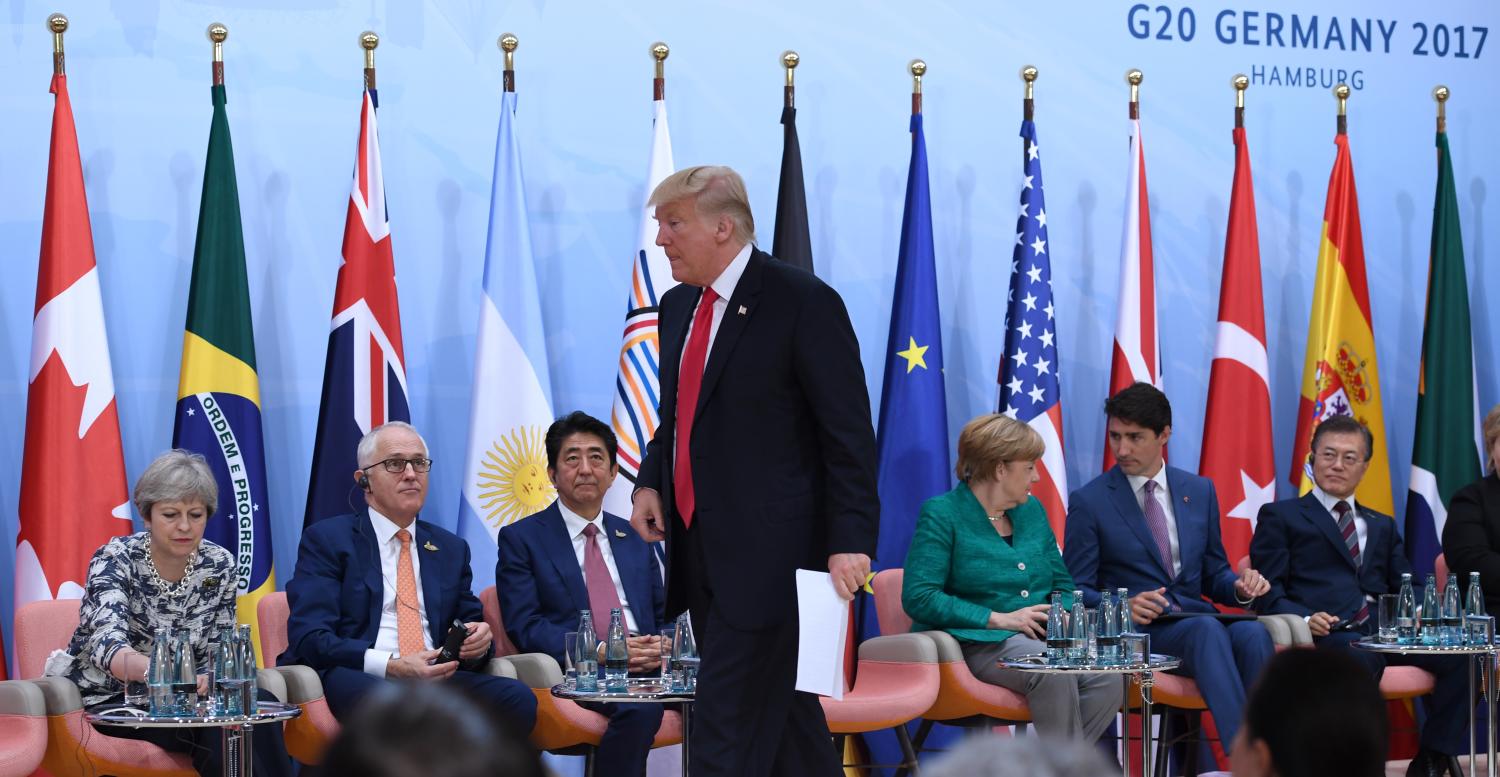“This year’s G-20 must be more than just a talkfest,” said Tony Abbott, Australia’s then Prime Minister (Abbott, 2014). Speaking at Davos in 2014, this was the central benchmark that Tony Abbott set for measuring the success of Australia’s G-20 host year. It is a benchmark few would consider unreasonable. But it is also a benchmark which implies that previous G-20 meetings have delivered little in terms of meaningful policy change.
Although young by institutional standards, the G-20 has had a significant focus on macroeconomic cooperation. Its focus has ranged from coordinated fiscal and monetary stimulus to avoiding competitive exchange rate devaluations, resisting protectionism, moving toward market determined exchange rates, strengthening the global financial safety net, creating common standards for financial regulation and taxation, and coordinating structural reforms to achieve a collective growth target and reduce global imbalances in trade and current accounts. [1]
But was this coordination rhetoric or reality? Does the G-20 influence the domestic policies of its members? Or are Mr. Abbott’s concerns correct: that claims of coordination are merely for show and countries tend to do what they would have done anyway?
There are reasons to be skeptical. Global crises, like that in 2008, tend to produce common incentives. When G-20 countries are hit by a common shock, they often have a prima facie incentive to undertake fiscal and monetary stimulus regardless of what other countries do. The domestic mandates of central banks, and the domestic incentives of politicians, may similarly suggest little room for global influence.
Fundamentally, policy in the United States won’t be pulled by international consensus, it will be driven by domestic policy considerations and domestic politics. There can be a backlash in the United States if you make the argument that you are doing something to comply with international rules. I faced an enormous challenge from Congress with regards to the FSB. I mean, for goodness sake, we created the FSB! It was trying to extend our policies as best practices!—Jacob Lew, former Treasury Secretary, United States, interviewed September 7, 2017.
Some areas of the G-20’s agenda may also be poorly suited to coordination. During Australia’s host year in 2014, the G-20 sought to coordinate the implementation of 1,000 structural reforms with the goal of lifting G-20 GDP by 2 percent by 2018. But structural reforms are often very country-specific, making cross-country comparisons difficult. Such reforms often entail ill-defined, long-run processes that challenge vested interests and require substantial political capital. Did G-20 countries really do anything different? Or did they merely repackage the reforms they were already undertaking?
The G-20 might also be taking credit for things it did not do. The G-20 has had a strong focus on reducing global imbalances in trade and current accounts, for example. But much of the post-crisis reduction in these imbalances may have been due to weak demand rather than anything the G-20 did.[2] Similarly, while the G-20 has been successful in moving toward more market-determined exchange rates, countries may have been moving in this direction already.[3]
The G-20 also exists in a world where global economic cooperation may be less necessary in some areas than it was in the past. Global agreements to realign currencies, such as the Plaza Accord in 1985 and the Louvre Accord in 1987, for example, are unnecessary in a global system of predominantly floating exchange rates and independent central banks. Perhaps it is natural, therefore, for global forums and agreements to have less influence today than they have previously.
Or is this skepticism too cynical? The G-20 has, after all, set new standards for financial regulation and bank capitalization. It reformed global institutions and created new ones to monitor the domestic policies of its members. G-20 countries surrendered fiscal and monetary space to international institutions like the IMF and through bilateral currency swap lines. It is implementing an ambitious global agenda on multinational tax avoidance and did well in avoiding competitive exchange rate devaluations and resisting a 1930s’ style rise in protectionism.[4] A theoretical framework in which the G-20 has no influence over domestic macroeconomic policies would struggle to explain these achievements.
I’m not convinced that, without the G-20 framework, countries would have had the political purchasing power within their national systems of governments to deliver the policy responses that were necessary during the crisis—Kevin Rudd, 26th Prime Minister of Australia, interviewed September 8, 2017.
While many papers have developed theoretical explanations of how global agreements influence domestic policies,[5] few have sought to assess this influence empirically, at least in modern times. For good reason. The era when policymakers would meet in Long Island and agree on the values of exchange rates are gone.[6] ‘Coordination’ has been largely replaced with “cooperation”—a subtler, longer-run process which can be harder to measure and harder to see in the data.[7]
The G-20 is a useful forum for central banks for understanding the broader policy context in other economies. It is also a useful forum in which central banks can explain the reasons for their policy decisions—Mark Carney, Governor of the Bank of England and Cahir of the Financial Stability Board, interviewed February 16, 2018.
Given these challenges, how can the G-20’s influence on domestic policies be measured in this new era of cooperation?
There is only one ex ante transmission mechanism between the G-20 and the domestic policies of its members, and that is the policymakers themselves. If policies are directly influenced by the G-20, it is because the politicians and officials who attended those meetings changed the domestic policies of their country because of what was agreed and discussed. As the old saying goes: if you want answers, go to the source.
This paper has done exactly that. It reports the results from in-depth interviews with 61 leaders, central bank governors, ministers and officials from across all G-20 countries. These are the individuals who make up the G-20 and are responsible for shaping the policies in their countries. The findings are testament to the generosity and openness of these policymakers in discussing their experiences in global economic cooperation. Participants included Kevin Rudd, Janet Yellen, Haruhiko Kuroda, Ben Bernanke, Jack Lew, Mark Carney and 55 other politicians and officials to whom I am deeply grateful.
The goal of these interviews was to explore five critical issues: What forms does global macroeconomic cooperation take? What are the ways in which the G-20 influences domestic policies? How strong is the G-20’s influence? How does this differ depending on the policy area, the size of the country and its level of development? And why does cooperation influence domestic policies in some areas more than others?
The critical finding of this paper is that global cooperation can influence, and has influenced, domestic macroeconomic policies. For example, the paper finds that 11 of the G-20 economies undertook more fiscal stimulus from 2008 to 2010 because of the G-20 than they otherwise would have done. It finds that the G-20 has prevented countries from depreciating their currencies, spurred them to resist protectionism, and helped them to improve communication and defuse tensions around monetary policy spillovers. It finds that discussions on monetary policy influences the thinking of central bankers and, through this, their policies. Although less common, the paper finds that some countries undertook more fiscal consolidation because of the G-20. Several countries implemented new, or more ambitious structural reforms because of the G-20 and some altered their policies to reduce their external imbalances.
Using the results from these interviews, the paper presents a new framework for thinking about how global agreements influence domestic policies. It categorizes the different ways in which global cooperation can take place, the transmission mechanisms for influence, and the variables which determine the strength of that influence.
The paper is structured as follows. Section 2 outlines the methodology for collecting and reporting the data used to build this framework. Section 3 explores how policymakers use the G20 and what they perceive to be its key value. Section 4 explores whether countries did anything different because of the G-20, and how the G-20 influenced domestic policies, in five areas: fiscal stimulus, reducing debt and deficits, monetary policy, reducing global imbalances and structural reform. Section 5 presents the new framework for thinking about macroeconomic cooperation and Section 6 concludes. It summarizes the main findings and explores what they mean for the G-20 in the future.
[1] Triggs (2018) explores how successful the G-20 has been in each of these areas.
[2] Ibid
[3] Ibid
[4] See Triggs (2018) for a discussion of whether the G-20 achieved its goals in macroeconomic cooperation.
[5] See Schirm (2013); Schirm (2016); Jones (2016); Frieden (2016) and Simmons (2000)
[6] This is referring to 1927 when, after the sterling came under strain, the Governors of the Federal Reserve Bank of New York, the Bank of England, the German Reichsbank and the Bank of France met secretly on Long Island and agreed to alter their respective monetary policies to ease pressure on the sterling (see Eichengreen, 2013).
[7] See Bayoumi (2014) on the distinction between cooperation and coordination.






